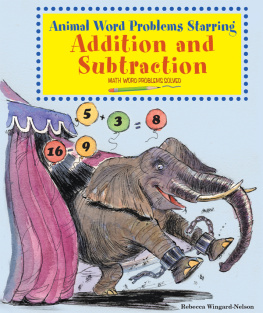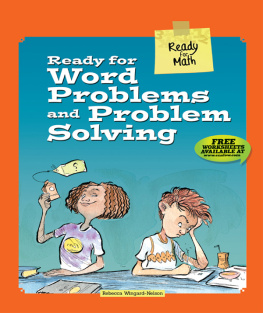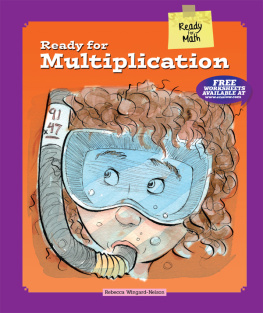Word Problems? No Problem!
HAVING A PROBLEM WITH WORD PROBLEMS? THIS BOOK INTRODUCES SIMPLE WAYS TO TACKLE TRICKY WORD PROBLEMS WITH ALGEBRA. REAL WORLD EXAMPLES MAKE THE BOOK EASY TO READ AND ARE GREAT FOR STUDENTS TO USE ON THEIR OWN, OR WITH PARENTS, TEACHERS, OR TUTORS.
FREE WORKSHEETS AVAILABLE AT ENSLOW.COM
"The author does a splendid job of clearly presenting material to help readers practice their problem-solving skills in algebra."
Patricia Leonard, MS, Series Math Consultant
Middle School Math Teacher
St. Andrew School, Clifton, NJ
About the Author
AUTHOR REBECCA WINGARD-NELSON has worked in public, private, and home-school mathematics education. She has been involved in various educational math projects, including developing and writing state assessment tests, exit exams, and proficiency tests, as well as writing and editing textbooks and workbooks.

When you hand a cashier a twenty-dollar bill to pay fora pair of socks, you're living in a word problem! Math is everywhere; you just might not realize it all the time because math isn't always written as a math problem.
This book will help you understand how algebra is used in word problems. The step-by-step method can help students, parents, teachers, and tutors solve any word problem. It can be read from beginning to end or used to review a specific topic. Let's get started!

Image credit: Comstock/PunchStock
When faced with a word problem, you many think, "How do I start? What do I do if I get stuck? What if the answer is wrong when I check it? Word problems are hard!" Here are some tips.

Image credit: Comstock/PunchStock
You can watch a swim meet and see swimmers racing across a pool. But if you want to learn how to swim, you must get in the water. Solving math problems is not a spectator sport. You may first watch how others solve word problems, but then you need to solve them for yourself, too. Go ahead, jump in!
Even the most gifted athlete or musician will tell you that in order to play well, you must practice. The more you practice anything, the better and faster you become at it. The same is true for problem solving. Homework problems and class work are your practice.
If you already know everything, there is nothing left to learn. Every mistake you make is a potential learning experience. When you understand a problem and get the right answer the first time, good for you! When you do NOT understand a problem but figure it out, or you make a mistake and learn from it, AWESOME for you!
Ask smart questions. Whoever is helping you does not know what you don't understand unless you tell them. You must ask a question before you can get an answer.
Ask questions early. Concepts in math build on each other. Today's material is essential for understanding tomorrow's.
Stuck on homework? There are many resources for homework help.
- Check a textbook.
- Ask someone who does understand.
- Try looking up sources on the Internet (but don't get distracted).
- Read this book!
Getting frustrated? Take a break.
- Get a snack or a drink of water.
- Move around and get your blood flowing. Then come back and try again.
Stuck on a test? If you do get stuck on a problem, move on to the next one. Solve the problems you understand first. That way, you won't miss the problems you do understand because you were stuck on one you didn't. If you have time, go back and try the ones you skipped.
Wrong answer? Check the math; it could be a simple mistake. Try solving the problem another way. There are many problem-solving strategies, and usually more than one of them will work. Don't give up. If you quit, you won't learn anything.
Solving math word problems can be broken down into four steps. You are more likely to get a correct answer and have less trouble finding it when you follow these steps.

Image credit: Shutterstock
Read the problem. Read the problem again. This may seem obvious, but this step may be the most important.
Ask yourself questions like:
Do I understand all of the words in the problem?
Can I restate the problem in my own words?
Will a picture or diagram help me understand the problem?
What does the problem ask me to find or show?
What information do I need to solve the problem? Do I have all of the information?
Underlining the important information can help you to understand the problem. Read the problem as many times as it takes for you to have a clear sense of what happens in the problem and of what you are asked to find.
Step 1: Understand the problem.
Step 2: Make a plan.
Step 3: Follow the plan.
Step 4: Review.
There are many ways to solve a math problem. Choosing a good plan becomes easier as you solve more problems. Some plans you may choose are:
| Make a list. | Guess and check. |
| Draw a picture. | Work backward. |
| Use logical reasoning. | Solve a simpler problem. |
| Use what you know. | Use a number line or graph. |
| Use a model. | Use a table. |
In algebra, one of the most important plans is write an equation. When this is the plan, the main task at this step is to choose the correct operation.
Now that you understand the problem and have decided how to solve it, you can carry out your plan. Use the plan you have chosen. If it does not work, go back to step 2 and choose a different plan.
Look over the problem and your answer. Does the answer match the question? Does the answer make sense? Is it reasonable? Check the math. What plan worked or did not work? Looking back at what you have done on this problem will help you solve similar problems.
Salem County school district cancels school when the temperature is 10 degrees or more below zero Fahrenheit. The temperature today is 12 degrees below zero Fahrenheit. What integer represents today's temperature?

Image credit: Shutterstock
Read the problem. Are there any words you do not understand? What does the word integer mean?
Integers are whole numbers and their opposites.
What does the problem ask you to find?
The integer that represents today's temperature.
What information do you need to solve the problem? Is all of the information that you need in the question? Is there extra information?
You need to know today's temperature. The information is in the question. You do not need to know that the school district cancels school when the temperature is 10 degrees or more below zero Fahrenheit. That is extra information.





















